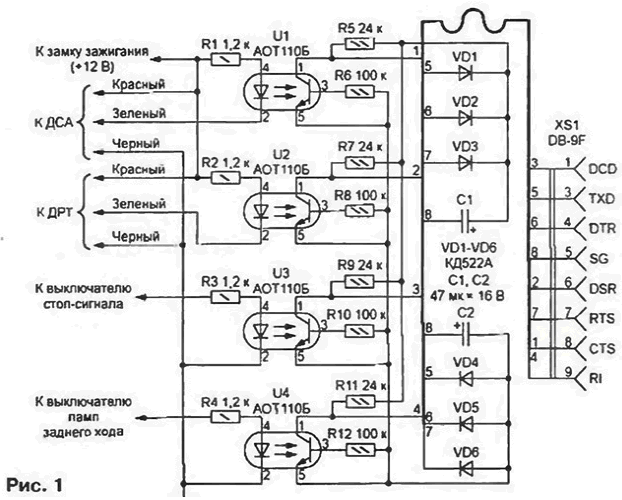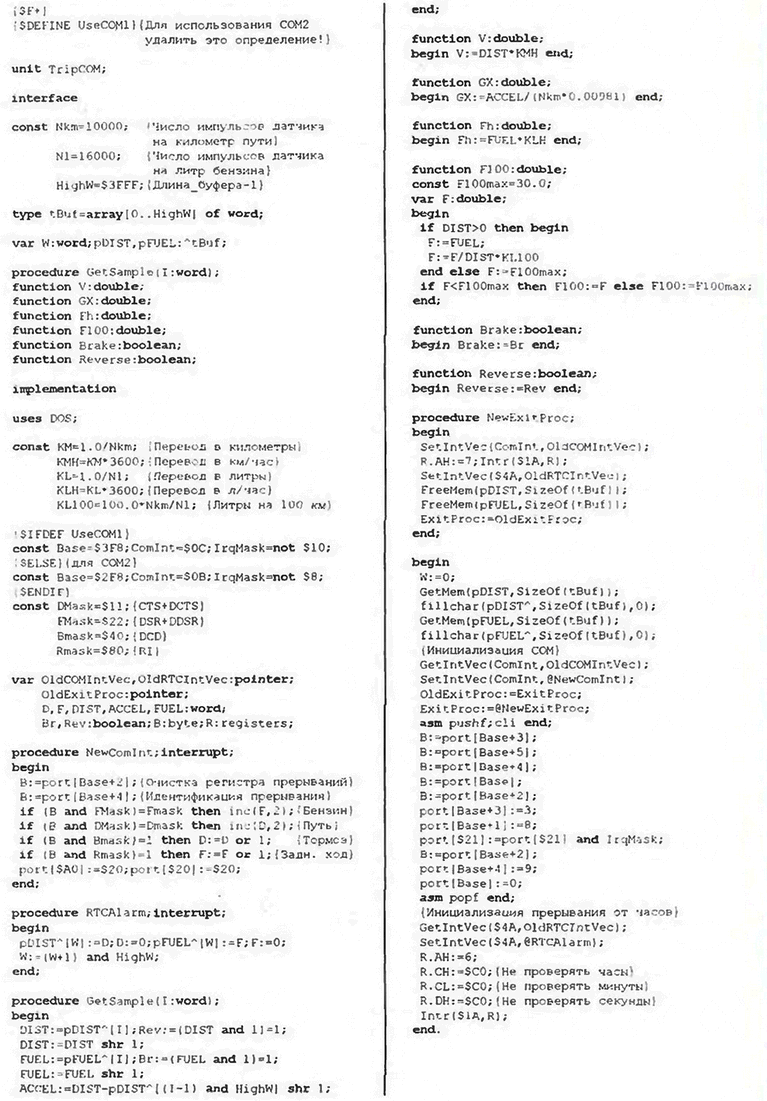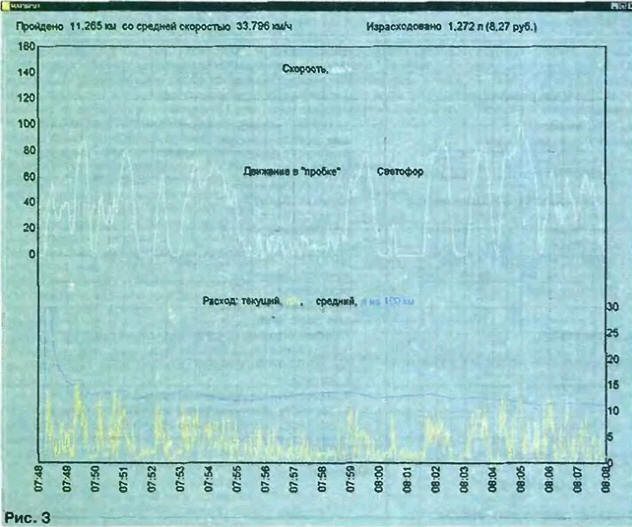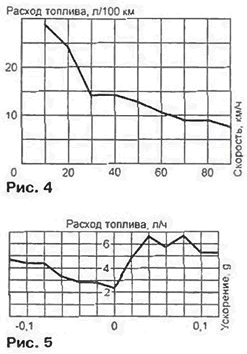Some models of automobiles equipped with trip computers MK-21093. This device, processing the signals of the speed sensors (ACD) and fuel consumption (DRT). displays the indicator elapsed travel time, distance traveled, average speed, fuel consumption (instantaneous, per trip or average per 100 km). Modification of the computer for cars VAZ-2110 measure, in addition, and some other parameters - Board voltage and temperature in the cabin and overboard. All this information is certainly useful, but, unfortunately, the indicator in each moment appears only one of the parameters, and when a cursory glance it is difficult to determine which one. And to switch modes almost blindly. The labels above the buttons are almost invisible, especially when lighting is poor. And to choose, for example, the most economical mode traffic, the driver has to constantly monitor the indicator of the computer being distracted from the road, and this is unsafe.
Using this routing computer, the driver after some time comes to the conclusion that the device is, of course, interesting, but... not. Another thing, if sensor readings can be recorded in a kind of "black box", and after trip to play. Here, have had the opportunity in a relaxed setting to bring the patterns and to consider them in the following travel. There is also a legitimate desire to receive the information, for example, about the remainder of the gasoline in the tank or the distance that can pass. Would be nice to have an audible alarm. Nude passed a predetermined distance, achieved (or exceeded) the preset speed. And if you install additional sensors, you can measure and indicate much more, until the vehicle's position on map of the city.
The idea to modify the existing on-Board computer was quickly discarded. The fact that the basis of computer - specialized microcontroller CRUZ-021 with mask ROM. the program is very difficult to "crack", but still more difficult to recycle. Even if it were possible to replace the microcontroller others say, a series of 1830 km. limited vozmozhnosti indicator (only four decimal places) and insufficient number of control buttons on the front panel the computer still will not allow anything to improve. As for recording the sensor readings, we work on making this system would have had to start "from scratch".
In General, it's one thing to create the trip computer again. But before as the "forging iron", a good idea to check in practice and to fulfill its basic the algorithms. And for this purpose the best portable laptop computer with a large LCD screen and a full keyboard. You only need to find a way connect it installed in the car sensors.
To develop and adjust the program of the computer fit all known programming tools for the IBM PC. The accumulated information record on a floppy or hard disk drive (trying to protect the drives from damage, do better during stops, at least at the traffic light). When the desire (and the availability of funds), you can record on solid state memory cards who is not afraid of mechanical impact. Play the record on the same or any other computer, and any methods are available mathematical processing and analysis.
CSA trip computer MK-21093 mounted on the shaft of the speedometer, making one turn per meter path. The output circuit of the sensor closes and opens ten times for each revolution, generating 10,000 impulses per kilometre. DRT from the same the kit generates 16,000 pulses per liter passed through it of gasoline. Both sensors require power from a 12 volt onboard network car.
The signals from the sensors, and to press on the brake pedal and reverse stroke is the most convenient submitted to the inputs available in each computer communication port. Diagram of the device shown in Fig. 1. It placed in any convenient location of the vehicle, and a cable socket XS1 connect with plug COM1 or COM2 of the computer. To receive signals from the inputs used port CTS, DSR, DCD and RI. Standard serial port adapter IBM-compatible the computer is able to automatically generate IRQ when changing logic level on any of them. Optocouplers U1-U4 provide mutual galvanic separation of circuits of the car and the computer. The voltage the collector and emitter circuits of transistors optocoupler forms a rectifier the diodes VD1-VD6. For normal operation of the device pairing set opposite logic levels on any two of the three available outputs (TXD, RTS, DTR).

If the car computer MK-21093 already installed and the sensors connected to it a staff. the necessary signals can be removed and with the MC, thus ensuring its simultaneous work with the laptop computer. You need to add the node pairing (Fig. 1) two-transistor inverters, as shown in Fig. 2.

Left under the scheme the terminal of the resistor connected to the specified pins DDI (CTL) mounted on the CPU Board trip computer. Note, it has two chips K561TTU. DD1 - that is approximately in the center of the Board. The voltage of +12 V to the node served with contact 5 fork HR, and a common wire connected to its pins 2, 7, or 8.
In vehicles equipped with an electronic control unit (ECU) of the company "General Motors, signal ACD can be removed from the contact B4 pink connector of this unit or with contact 2 cosmicomiche (white) connector wire harness instrument panel and the engine management system. The signal DRT is removed from the contact C2 blue connector The ECU or pin 3 of the above-mentioned connector. The signal wire CSA in the wiring system engine control - blue with red and has the number 42. and DRT - yellow black, number 71. For interfacing with COM port-the computer that has a valid take advantage of the already described by the node with the addition according to Fig. 2.
The source text of the program module TripCOM. processing sensor signals, given in the table. In the initialization process, it requests and receives from operating system required volume of memory for arrays of data sets the desired operation mode of the serial port and the PC's clock real-time using 06 interrupt AN configures so that they every second generate IRQ ON. Before shutting down the module automatically calls the procedure NewExrtProc. restoring the status quo".

(click to enlarge)
Interrupts generated by the serial port adapter, if you change any of the input signals processed by the procedure NewComlnt. It determines which of the sensors received pulse, and increases by two readings corresponding of the counter. Significant bits of the counters in the counting pulses are not involved. In one of they procedure writes a logic 1 if pressed the brake pedal and the other if the reverse gear is engaged.
Every second interrupt from the clock handles the procedure RTCAIarm. reading the counters of impulses received from the ACD and DRT. After reading variables are set to zero, the numbers that are entered into the array addressed pointers pDIST and pFUEL, proportional (excluding Junior level) accordingly passed in the last second distance and expended for this same interval the fuel volume. Significant bits of the numbers say about the state of the brake pedal and the reverse gear is engaged. The variable W is the index the cell (the same for both arrays), which will be produced next entry. After reaching the end of the array the filling will start from the beginning. As the size of the array in the IBM PC may not exceed 64 Kbytes, it is necessary through every 8.. 9 hours of continuous operation data from RAM or automatically by the operator to save on the hard drive (or other external media).
Reading and processing of data from arrays - primary care program that is not is due to the large volume. Our readers can find her on the website www.paguo.ru. She actively uses the module TripCOM. including the existing the transfer feature counters into instantaneous values of speed of movement in km/h (V). fuel consumption in l/h (Fh) and 100 km (F100). Function GX returns computed according to the ACD values of the longitudinal overload (in units d). occur during acceleration and deceleration of the vehicle.
The value of the logical functions of Brake and Reverse is true if accordingly pressed the brake pedal or the reverse gear is engaged. Procedure GetSampIe specifies the above-mentioned procedures and functions which count meter readings should be processed, and performs over it some preliminary operations. This procedure should be called every time you change processed "seconds".
Sensor parameters are specified constants Nkm (the number of pulses CSA per kilometer) and N1 (the number of pulses DRT per liter passed through the fuel). If the car is equipped with sensors that differ from the included computer MK-21093, just change the appropriate values in the constants section section interface module TripCOM. For example, for the above-mentioned ECU Nkm must be equal to 6000.
A few words about the features of the calculation of the instantaneous fuel consumption per 100 km path. In the corresponding formula for the velocity of the vehicle is in the denominator, so driving slow, you can overflow bit of the mesh processor, and during stops - division by 0. To avoid these errors, computer MK-21093 calculates fuel consumption per 100 km only when driving at a speed of 27 km/h In the function F100 reporting module taken against overflow, and the return value regardless of the speed is limited value F100max (in our case equal to 30 liters).
Example graphs based on the data recorded when the vehicle VAZ-21099 on the streets of Moscow, is shown in Fig. 3. Curve speed thanks the inertia of the car is very smooth, which cannot be said about the urban fuel. Its irregularity is not possible, constantly looking at changing reading the digital display of the computer MK-21093. to accurately determine the current value. The curve of fuel consumption per 100 km is shown in Fig. 3, built averaged over a few minutes values, which makes it more a visual.

The trip took place in the traffic in the morning rush hour. Fast movement (sometimes exceeding the speed limit) alternated with stops at the lights. One of them (about 8 h 1 min) managed to overcome only in the second cycle of its operation. A few minutes starting at 7 h 55 min the car was crawling in traffic. Only 20 minutes had passed just over 11 km and spent 1.3 litres of petrol. For comparison, when riding in the same vehicle with approximately constant high speed (for example, on the Moscow ring the highway is 100 km spent 5...7 liters of gasoline.
Statistical processing of the recorded information to identify patterns, of interest for drivers and professionals automotive technology. For example, in Fig. 4 shows the dependence of fuel consumption from the average speed of city traffic, and in Fig. 5 - from the acceleration of the car during acceleration and engine braking.

Graphs constructed using mean values parameters for several trips without additional processing (smoothing).
Author: A. Sergeyev, Moscow






